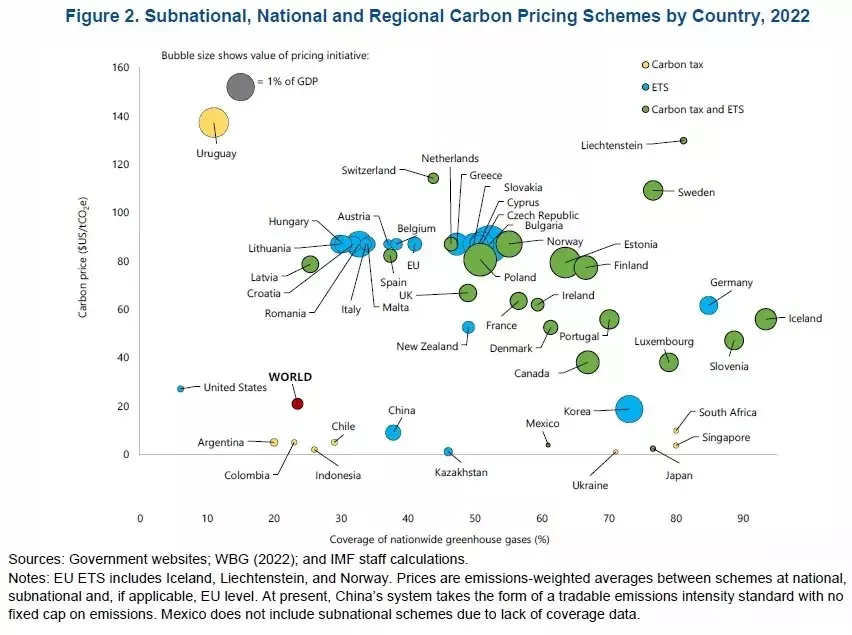Comments
- No comments found

The global movement toward carbon pricing is partial and halting, but real.
Ian Parry, Simon Black, and Karlygash Zhunussova provide some useful background and analysis in “Carbon Taxes or Emissions Trading Systems? Instrument Choice and Design (July 21, 2022, IMF Staff Climate Note 2022/006).
This figure illustrates carbon pricing around the world. Putting a price in carbon emissions can happen in different ways: for example, through a carbon tax or through an emissions trading system (where emitters must own permits for the quantity of their emissions, and these permits can be bought and sold). The horizontal axis shows what share of carbon emissions from that jurisdiction are covered by a carbon price. The horizontal axis shows the carbon price converted to US dollars per ton of CO2-equivalent emissions (that is, if it’s a greenhouse gas that isn’t carbon, it’s converted to an equivalent).

The world average for carbon pricing is the red point near the bottom left: that is, about 25% of global carbon-equivalent emissions are covered by some form of carbon pricing, at an average price of about $25 per metric ton of carbon-equivalent emissions. Some countries have coverage of most emissions, but at a very low price (Japan, South Africa). Others have coverage of only a small share of their emissions, but at a high price (Uruguay). In the upper right are the countries with high coverage and a high carbon price (Sweden and Liechtenstein).
There are of course lots of subsidiary questions here, which are discussed by the authors. Here’s a quick flavor of some of the questions.
There is the question of what policy tool is preferable. A carbon tax has the advantage that it clarifies the path of future prices, which helps private firms and households in making their choices about how to adapt. But a carbon tax doesn’t directly set a limit on carbon emissions. A system of emissions trading permits does set a quantitative limit. But the carbon price is then determined by interactions with the market for permits, which creates a degree of uncertainty for future planning. And of course, either approach can be enacted with a variety of loopholes, grandfather clauses, and offsets that could weaken its force.
There is the question of overlap with carbon pricing tools and other policy mechanisms. For example, consider the possibility that carbon taxes were substituted, in part, for existing fuel taxes, or for existing miles-per-gallon standards for cars. The economic incentives would shift toward a more direct focus on carbon emissions. A political tradeoff along these lines might bring some who are dubious about carbon pricing on-board.
Finally, there is a question of what a broad-based tax for all greenhouse gas emissions looks like. Applying a carbon price (whether via tax or emissions trading system) to direct production of fossil fuels (or to usage of imported fossil fuels) is fairly straightforward. But what about provisions that affect methane that is now released as part of fossil fuel production? What about greenhouse gas emissions (say, by various soil practices and livestock) or generated by agriculture or by industry (say, by cement manufacturing)?
Timothy Taylor is an American economist. He is managing editor of the Journal of Economic Perspectives, a quarterly academic journal produced at Macalester College and published by the American Economic Association. Taylor received his Bachelor of Arts degree from Haverford College and a master's degree in economics from Stanford University. At Stanford, he was winner of the award for excellent teaching in a large class (more than 30 students) given by the Associated Students of Stanford University. At Minnesota, he was named a Distinguished Lecturer by the Department of Economics and voted Teacher of the Year by the master's degree students at the Hubert H. Humphrey Institute of Public Affairs. Taylor has been a guest speaker for groups of teachers of high school economics, visiting diplomats from eastern Europe, talk-radio shows, and community groups. From 1989 to 1997, Professor Taylor wrote an economics opinion column for the San Jose Mercury-News. He has published multiple lectures on economics through The Teaching Company. With Rudolph Penner and Isabel Sawhill, he is co-author of Updating America's Social Contract (2000), whose first chapter provided an early radical centrist perspective, "An Agenda for the Radical Middle". Taylor is also the author of The Instant Economist: Everything You Need to Know About How the Economy Works, published by the Penguin Group in 2012. The fourth edition of Taylor's Principles of Economics textbook was published by Textbook Media in 2017.
Leave your comments
Post comment as a guest